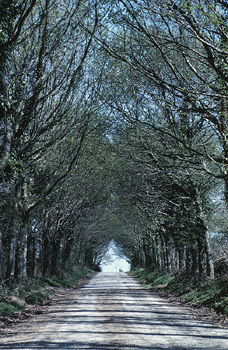Basic Perspective: Linear and Atmospheric
Perspective is a system for drawing, used to create the illusion of 3-dimensionality (volume and depth) on a 2-dimensional surface (flat). For example paintings, drawings, illustrations, prints, etc. Perspective theory consists of two separate parts: Linear Perspective and Atmospheric Perspective.
Linear perspective is based on the principle of Diminution, meaning that things appear to get smaller as they move away from the viewer. It uses Converging Lines that go to Vanishing Points to create 3-dimensionality. Transfer of Scale is used to maintain accurate proportion.
Linear Perspective: The trees get smaller, the road becomes more narrow and goes towards a vanishing point.

Linear Perspective: The gravestones appear to become smaller.
Atmospheric Perspective
Atmospheric perspective is the effect of light and moisture in the atmosphere that enables the viewer to see distance and depth by variations of value, saturation, temperature, and edges.
In a daylight situation, depth is created by objects becoming lighter in Value, with less contrast, the farther away they are. In a situation where the background is dark, objects become darker in value, with less contrast, the farther away they are. For example, at night, in caves, wooded areas, alleyways, rooms, etc.
— Edges become softer and less focused.
— Objects become less saturated in color.
— The temperature of the color becomes cooler (i.e. more blue).

